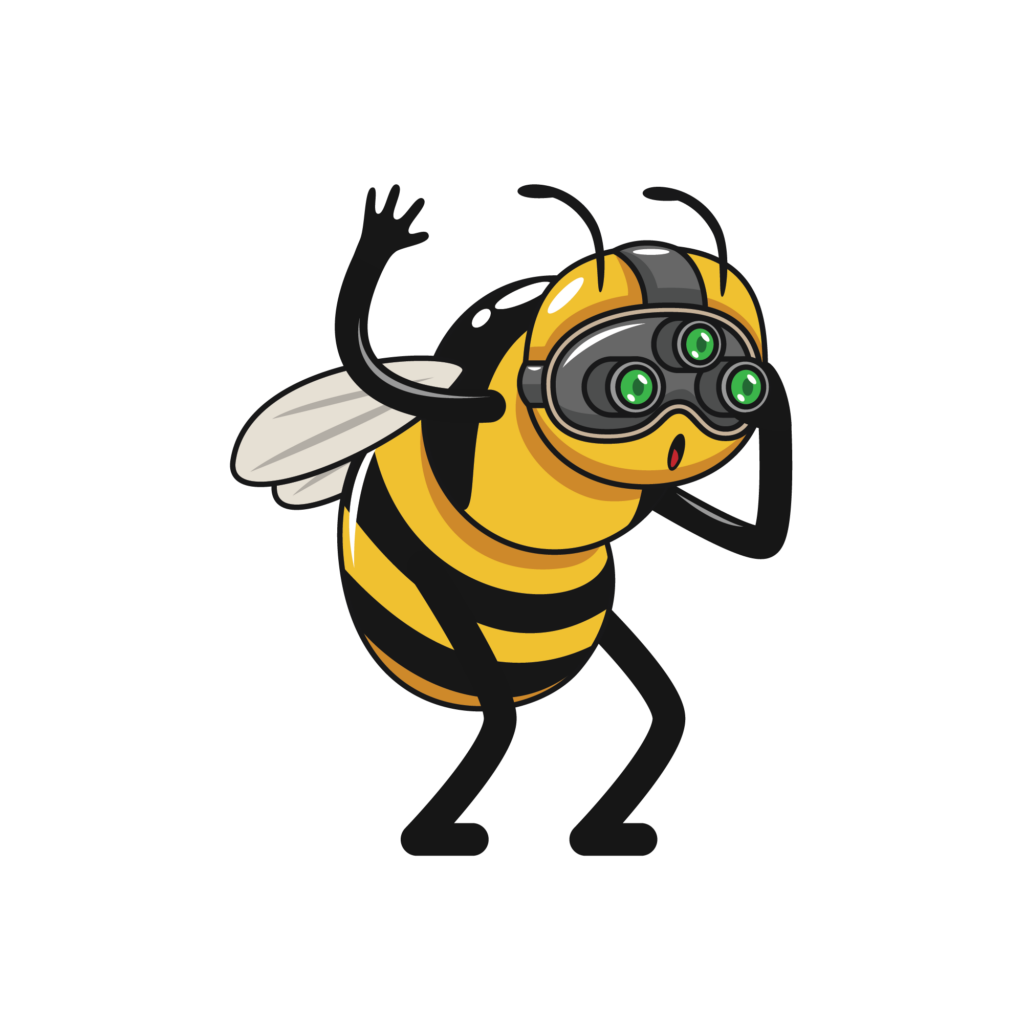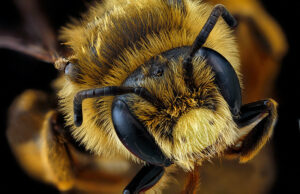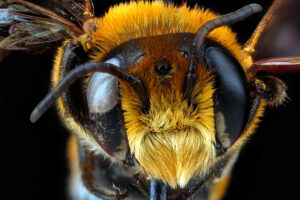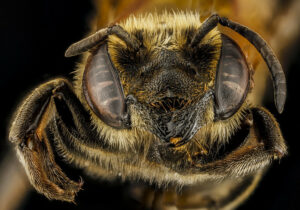Last updated on January 3rd, 2024 at 02:44 pm
Can bees see in the dark? Well, hold on to your beekeeper hats, folks! A groundbreaking study has unveiled that some bees, like the Asian giant honeybee, have developed the ability to see colours in dim light, while others may have held this superpower for longer than we’ve known.
Yep, you read that right – these bees have night vision! This is a game-changer in our understanding of bee vision and behaviour.
In a recent study, it was discovered that some bees, such as the Asian giant honeybee (Apis dorsata), possess the ability to see colours even under low light conditions, for example during half-moon nights.
This finding is quite remarkable, as it challenges the idea that most animals, including humans, can’t see colours well in dim light.
The Study That’s Stirring the Hive
Published in the Royal Society of Publishing, the study titled “Dim-light colour vision in the facultatively nocturnal Asian giant honeybee, Apis dorsata” has opened up new avenues of research.
Key Findings
- Asian giant honeybees can see colours in low light conditions.
- This ability challenges our previous understanding that most animals can’t see colours well in dim light.
This isn’t just a quirky fact; it’s a revelation that could impact how we understand pollination and even conservation efforts.
We already knew that certain moths and carpenter bees could see colours in low light, suggesting they have special adaptations for nocturnal vision. These adaptations are essential given the significant role bees play in pollinating plants, including during nighttime.
1996 Study – Can Bees See In The Dark?
Similar studies were carried out back in 1996 and published in the Royal Society of Publishing with the study being titled “Neural image enhancement allows honeybees to see at night“. So the question is, how long have bees been able to see in the dark?
Researchers from Sweden and Germany have an intriguing answer: these bees are using their brains to amp up their night vision.
Let’s dig into this buzzing mystery!
The Paradox of Bee Night Vision
Bees should technically be blind at night but can bees see in the dark? Their eyes are not designed for dim light, unlike some nocturnal insects that have specialized eyes for the dark. Eric Warrant, a neurobiologist at Lund University in Sweden, even goes as far as to say, “At night the bee’s eye is quite hopeless.”

Night Vision in the Animal Kingdom
Most animals, including us humans, switch from seeing colours in daylight to shades of grey at night. But some insects have evolved unique adaptations to see in the dark.
Overcoming the challenges of nocturnal vision and understanding how these insects perceive colour at night can provide insights into their eyes and interactions with flowers in the dark.
For example, unlike humans, bees do not rely on the relative brightness of colours in dim light conditions, yet they can still recognise and prefer certain colours.
How Do Bees See in the Dark?
Researchers conducted experiments to understand how these bees perceive colours in low light. Turns out, brightness isn’t a reliable cue for them. Despite this, they can still recognize and prefer certain colours even when the sun’s taken a break.
The Asian giant honeybee is now the second insect known to see colours in low light with eyes similar to ours. Carpenter bees were the first to demonstrate this ability.
Investigating the nocturnal vision of bees is crucial as they play a significant part in plant pollination, helping produce fruits and seeds, contributing to food sources and maintaining healthy ecosystems.



The Science Behind the Mystery
To crack this enigma, researchers from Lund University, the University of Würzburg, and the University of Constance used computer simulations based on the optical and physiological properties of bee eyes. They aimed to predict how well a bee should be able to see in varying light conditions.
The Experiment
Researchers trained 44 honeybees to associate vertical stripes with a honey treat. These trained bees were then placed in a dark chamber with two passages: one ending in horizontal stripes and the other in vertical stripes. The thickness of the stripes was gradually reduced until the bees couldn’t distinguish between them anymore.
The Findings
- Bees chose vertical stripes thinner than what the model predicted they should be able to see.
- This suggests that bees use brainpower to enhance their night vision.
How Do Bees Pull This Off?
According to Warrant, bees likely use image processing tricks in their brains to see in the dark. Two strategies are possible:
- Extended Photoreceptor Time: Like a camera’s slow shutter speed, the brain might extend the time photoreceptors collect light before sending a signal.
- Pooling Photoreceptor Signals: Neighboring photoreceptors could combine signals to create a brighter, albeit less detailed, image.
Pros and Cons of Bee Night Vision Strategies
- Pros: Enhanced ability to see in the dark.
- Cons: Reduced image detail and potential for motion blur.
Warrant believes that bees probably use a combination of these strategies, despite the drawbacks. In his words, “It’s a case of being able to see something rather than nothing at all.”
Why Does This Matter?
Bees are the unsung heroes of pollination. They’re crucial for plant reproduction and, by extension, our food supply. Understanding how they interact with flowers at night could be a game-changer for environmental conservation.
Evolution has driven bees, predominantly diurnal creatures, to develop such adaptations for various reasons. These can include competition for resources within their species, forcing some groups to fetch food in alternative ways to sustain themselves, or avoiding nocturnal predators.
Possessing night vision in these cases increases their chances of survival, detects threats, and helps evade predation effectively.
Why Bee Night Vision is Important
- Enhances our understanding of pollination.
- This could lead to better conservation strategies.
- Helps us understand bee behaviour and evolution.
The Evolutionary Buzz
Why would bees, primarily day-loving creatures, evolve night vision? Two words: survival and adaptation. Whether it’s competition for food or dodging predators, evolving night vision gives these bees an edge in the survival game.
Possible Reasons for Evolution
- Competition for resources
- Avoiding predators
Advantages of Nighttime Foraging
- Less competition for nectar.
- Access to unique, night-blooming flowers.
- Untapped nectar reserves in the early morning and late evening.
Tropical Treasures
In tropical regions, some flowers only bloom at night, offering a generous supply of nectar and pollen. This nocturnal buffet likely encouraged bees to adapt and forage during darker hours. The nectar reserves of these newly opened flowers are often untapped, making early morning and late evening foraging especially rewarding.
The Nighttime Nectar Hunt
At night, the usual hustle and bustle of daytime pollinators like butterflies, beetles, and birds are absent. This leaves only a few competitors like bats and moths, making nighttime a lucrative time for nectar collection.
The Dry Environment Factor
Bees in arid regions have another reason to love the night. Flying during the cooler morning and evening hours helps minimize water loss, a crucial survival tactic in dry environments.
Final Thoughts
So, do bees fly at night? Some certainly do, and they have compelling reasons for it. Whether it’s the reduced competition, the allure of night-blooming flowers, or the need to conserve water, these bees have adapted in remarkable ways to take advantage of the night.
Bees are full of surprises, and their ability to see at night is just another testament to their incredible adaptability. While their eyes may not be built for the dark, their brains certainly make up for it. It’s a fascinating glimpse into how even the tiniest creatures can adapt in the most unexpected ways.
The discovery of night vision in the Asian giant honeybee and its potential relevance to other bees and pollinators contributes to our understanding of the adaptations and evolved traits necessary for survival in changing environmental conditions.
By learning about these unique abilities, we can better appreciate the complex relationships between pollinators, plants, and the ecological systems that support our food sources and environment.



